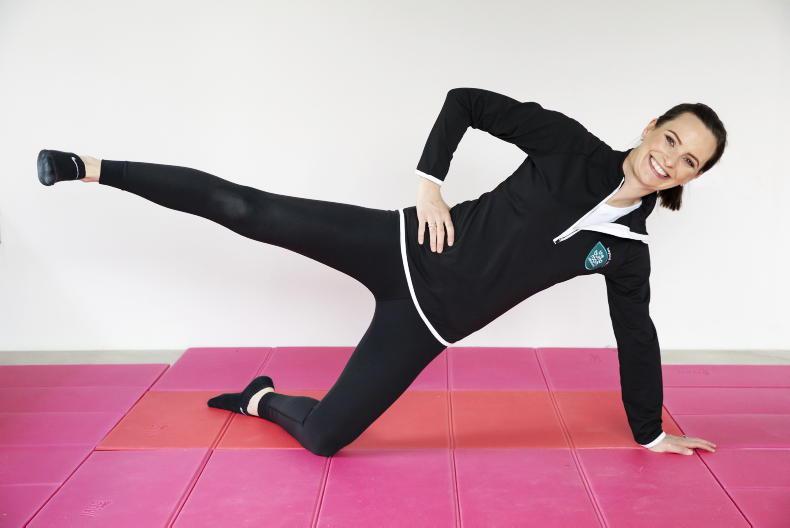It was while working as a physiotherapist at Cork University Maternity Hospital that Fiona Healy first discovered her passion for supporting women post pregnancy.
“I really felt like that was a place you could make a difference,” she reflects. “Women, they have their baby and they might get a six-week check; but that’s kind of it then.”
And today, Fiona is a women’s health physiotherapist specialising in pregnancy and post-natal related dysfunction in Kerry Physiotherapy Centre in Killarney. She also teaches postnatal Pilates and created the “Beyond Birth” programme with The Bump Room, which specialises in physio-led pregnancy and post-natal fitness classes in person and online.
However, an appropriate level of exercise is very important for women after having a baby
Fiona – who lives on a sheep farm in Tousist, near Kenmare, with her husband James and daughters Róisín (six) and Caoimhe (four) – explains why pregnancy can take its toll physically.
“Your tummy muscles get stretched in one direction, your pelvic floor down in the other direction, and your back is under pressure,” lists Fiona. “There is a lot of change going on.”
Moreover, if somebody has a difficult birth experience, they might experience other problems. Indeed, issues that Fiona sees in her clinic include all three forms of prolapse (bladder, uterine and rectal), incontinence, pelvic pain and diastasis recti, where the abdominal muscles have separated.
Some women will suffer with these conditions in silence.
“I had a lady with a faecal incontinence that had never told her husband,” recalls Fiona. “I was the only other person who knew about it.”
Returning to exercise
Issues postpartum can also mean that some women find it difficult to return to the exercise they enjoyed before having their baby.
“Even the inability to control wind would affect a lot of women’s confidence to go to a class or confidence to exercise,” says Fiona. “So many of our women who are not exercising may have some underlying issue like that that they’re not addressing or acknowledging sometimes because I think there can be a big disconnect…especially after a difficult birth.”
However, an appropriate level of exercise is very important for women after having a baby e.g. for improving mood, general health and bone density.
“Our bone density is decreasing every year from when we are 21 or 22 and we’re having babies later. I was listening to a lecture there that described it as when post-natal and peri-menopause collide and it’s so true,” she says.
“We’re having babies at this critical point… so it’s so important that we’re getting weight-bearing exercise.”
Mommy MOT
Whether they are experiencing an obvious issue or not, however, Fiona recommends that new mothers consider a “Mommy MOT”; ie a check-up with a women’s health physio from around six weeks postpartum.
This typically involves checking back, hip and pelvic movement, diastasis, scar flexibility and sensitivity, and with consent, an internal examination for performance of the pelvic floor and possible prolapse.
This can troubleshoot some issues before they become a bigger problem.
“There’s a cohort of women who maybe don’t have a prolapse immediately post-birth but they have this measurement – basically the vaginal opening is extended for this period, it will go through a process of recovery- but if they go jumping and hopping around the place, they could prolapse,” explains Fiona.
“So that’s some of the reason for the Mommy MOT is to try and catch the ladies before they create unnecessary problems.”
Build gradually
Based on the results, the physiotherapist can then put together a programme to address any issues discovered, and start paving the way for a return to physical activity.
But the first basic exercise to get right is one we hardly ever think about: breathing.
“Pregnancy pushes your diaphragm right up. Your belly goes out, your pelvic floor goes down. In our ‘normal’ body, when we breathe in, our diaphragm descends and our pelvic floor drops down so they work in unison with each other. That should be a constant interplay in our body and that mechanism gets disrupted and that is the first thing to get back,” says Fiona.
Even six months’ post-natal, your body might not be ready for a full jumping jack
Strength-building exercises can also be re-introduced gradually; but it’s important to adapt them for the postpartum body.
“You could start your squats off the side of the couch so you’re that little bit elevated, you’re still getting a little bit of leg work,” gives Fiona as just one example. “And you’re gradually making your squat a little harder, your lunge a little harder, you might do some side leg-lifting, really working on the hip control.”
Meanwhile, in terms of cardio, the static exercise bike or cross-trainer (glider) are both good options, while it is also possible to adapt exercises that are designed to raise the heart-rate, without putting pressure on the pelvic floor.
“Even six months’ post-natal, your body might not be ready for a full jumping jack; but you could do a step jack where you are doing a half jack but you’re still getting your heart rate up, or you can be marching up and down on a step,” says Fiona.
For higher-impact exercises like running, it’s very important to build up to it. According to the Return To Running guidelines, for example, you should be able to fulfil a number of strength tests before starting running eg complete a single leg sit to stand test x 20 reps.
Ultimately, however, Fiona says that there is no “perfect exercise” post partum; it’s about looking at where you want to go and building up to it.
“If you gradually build yourself up, you will get there,” she surmises. “It’s about giving your body the right exercise at the right time.”
For further information, visit thebumproom.ie & kerryphysiotherapy.ie






 This is a subscriber-only article
This is a subscriber-only article










SHARING OPTIONS: